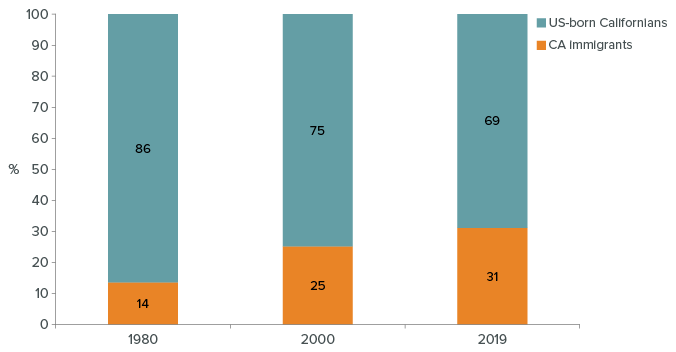- Educational attainment among recent immigrants has risen markedly.
In 2019, 52% of working-age immigrants (age 25–64) who had lived in the US for five years or less had bachelor’s or graduate degrees, up 31 percentage points since 1990. In contrast, the share of college graduates among US-born Californians was 38% in 2019, up 11 points since 1990. Among recent immigrants, 17% had not graduated from high school in 2019, compared with nearly half (47%) in 1990.
Recent immigrants have higher levels of educational attainment than US-born Californians

- Most recent immigrants are from Asia—and most Asian immigrants are college educated.
In 2019, 56% of recent working-age immigrants were from Asia, more than twice the share from Latin America (27%). Immigrants from India are the fastest-growing and most educated group in California: the working-age immigrant population from India has increased six-fold since 1990, and 81% of these immigrants have college degrees. - Immigrants make up a growing share of California’s highly educated workforce . . .
Immigrants account for about 31% of California workers age 25–64 with at least a bachelor’s degree, up from 20% in 1990. Immigrants with a college degree work in every major industry in the state and are especially well-represented in the technology and health sectors. A majority (63%) of college graduates in electronics and product manufacturing are immigrants, as are about half of workers in software publishing (42%) and computer systems design (47%). Immigrants also make up 59% of college graduates in skilled nursing facilities.
- . . . but immigrants also comprise an outsized share of workers with little formal education.
In 2019, 29% of working-age immigrants in California had not graduated from high school, compared to 7% of US-born Californians. An additional 20% of immigrants in California finished high school but did not attend college, similar to US-born residents (21%). Immigrants make up a large share of workers in industries that typically require little formal education, including agricultural production and the hospitality industry, accounting for 75% of California workers with less than a high school degree. - Strong educational progress occurs across generations.
In California and the nation as a whole, the adult children of immigrants (i.e., second-generation adults) tend to be much more highly educated than their parents. Almost all (93%) second-generation adults age 30–39 are high school graduates, compared to only about two-thirds (65%) of immigrant parents age 60–69. While second-generation adults are also more likely to earn a bachelor’s degree than their parents’ generation (36% vs. 28%), they are less likely to do so than other US-born adults (48%). This suggests the need for more targeted efforts to increase college access and completion among students who would be the first in their families to earn a bachelor’s degree. - Many California college students are foreign born.
Foreign-born students, including permanent residents and those on student visas, make up a larger share of postsecondary enrollment in California than any other state. These students comprise 18% of undergraduate and 27% of graduate and professional school students. Intended degree fields among foreign-born students align with California’s need for highly educated workers, especially in fast-growing STEM jobs. Among California college students, 46% of engineering and 42% of computer and information sciences majors are foreign born. - Most Californians favor protections for undocumented students.
An overwhelming majority of Californians (86%) favor protections—Including protection from deportation and a work permit—for immigrants brought to the US as children. The California Dream Act (passed in 2021) allows undocumented students who attended high school in California to pay in-state tuition and be eligible for the state’s student financial aid programs.




